Clematis in the fall is primarily necessary prepare for the upcoming winter. But many lovers of these flowering vines have a whole series of questions related to what can and should be done with plants at this time of year.
Here are some of them:
- How to plant clematis in the fall.
- How to replant clematis in the fall.
- Is it possible to propagate clematis in the fall?
- How to care for clematis in the fall.
Let's take a closer look at each of them. Let's start with the first one.
Planting clematis in autumn
When to plant. The best time for autumn planting of clematis is September. It should not be planted later. After all, winter is ahead, and the young seedling needs time to take root and adapt to a new place.
If you purchased a seedling at a later date, it is better to let it overwinter in the cellar or basement, and plant it in the spring. Just make sure that young shoots do not start to grow. If such shoots appear, they must be pinched periodically.
Once again I want to emphasize: planting clematis in the fall is best done in September!
Where to plant. Clematis can grow in one place for up to 30 years. Therefore, choose the planting site carefully so that you don’t have to replant later.
And although this plant is far from capricious, under certain conditions it will grow poorly or will not be able to grow at all. In the southern regions, you should not plant clematis in the full sun, especially close to the wall of a house or near an iron fence.
Drafts are also destructive for it, because the shoots of clematis are thin and very fragile, and the flowers are large and heavy. The wind will simply flutter them and break them off.
If water constantly drips from the roof onto him, then he, too, will most likely die.
The soil. Clematis are not very picky about soil, but they do not like acidic soil pH<6.5. The groundwater level should be no higher than 1.2 m. Wetlands are not suitable for planting at all.
Distance between bushes. Bushes should be planted no closer than one meter from each other, it is better if this distance is 1.5 m.
How to plant clematis correctly. Planting clematis in both autumn and spring is somewhat different from planting other plants. It must be planted quite deep. Not only the root collar should be below the soil level, but also the lower pair of buds on the shoot.
This is necessary so that the young seedling begins to bush faster. And the root system in cool soil develops much better and suffers less.
The planting hole will have to be dug quite impressive, at least two shovels deep. If the site has heavy, clayey soil, then a nutritious earthen mixture must be prepared to fill the planting hole. You can take humus, turf soil, peat and sand in equal quantities. In any case, add two glasses of ash, a glass of lime and 100 - 150 grams to the ground. com. min. fertilizers
It is better to cover the root collar and buried shoot not with soil, but with sand mixed with ash. When planting clematis in autumn, cut off the above-ground part to the ground or leave no more than two buds. Be prepared for the fact that next year the seedlings will grow slowly and the shoots will be very thin. It's quite normal. Clematis show themselves in all their glory only after 3 - 4 years.
Transplanting clematis in autumn
When to replant. If you need to move clematis to a new location, keep in mind that autumn replanting is preferable to spring replanting. Just remember that it is best to plant and replant this plant in September. Before winter sets in, your pet should
have time to “settle in” in a new place.
Is it possible to replant old clematis? There should not be any special problems with young bushes.Try to remove it with a clod of earth and carefully transplant it to another place. But with old bushes everything is much more complicated. There are even statements that it is impossible to replant plants older than 6 - 7 years. Quite often I had to plant and replant clematis and I can say that even old bushes can tolerate replanting. But it must be said that such bushes will not bloom next summer, and they will only increase their growth slightly.
The difficulty is that old clematis have long, powerful roots. It is simply impossible to remove such a bush from the ground without damaging the roots.
How to transplant clematis correctly. To replant an old bush, it must be dug to a depth of at least two bayonets. Then cut off the roots and drag this colossus to a new place of residence.
Plant according to all the rules: with deepening, adding fertilizers to the planting hole and good watering. When transplanting in autumn, all shoots should be cut off at the level of 1 - 2 buds.
Transplanting clematis due to illness. If during the summer you find signs of wilt (clematis wilting) on the bushes, then in such cases it is recommended to transplant the affected bushes to another place in the fall. Before planting, the roots of the extracted bush must be thoroughly washed from the ground. For prevention, water the planting hole with Trichoflor (5 g per 10 liters of water). After planting, sprinkle the ground around the bush with ash.
Reproduction of clematis in autumn
Clematis can be propagated in the fall. Most often they choose to do this:
- Dividing the bush.
- Reproduction by autumn layering.
Clematis division
Dividing young clematis. Bushes up to 5-6 years old are dug up, the roots are washed from the ground and
cut or cut into several parts.Each division should have good roots and at least one or two shoots. In extreme cases, several growth buds on the root collar.
Dividing old bushes. If an old clematis bush is chosen for division, then it is better to cut it down as follows. Dig up this bush on one side. It is better to make the hole deeper. Rinse the exposed part of the root with a hose, so you can better see where it is more convenient to cut the rhizome. Use a shovel or ax to separate part of the root along with several shoots. After planting, trim the shoots to two buds.
Note! Autumn propagation of clematis by division should be carried out at the same time as planting and replanting, i.e. in September. For the same reasons.
Reproduction of clematis by autumn layering
In my opinion, propagation of clematis by autumn layering is the simplest and at the same time very productive method of propagating this plant. With this method, the shoots are simply buried in the ground and within a year, an independent bush develops from almost every internode.
How it's done. Everything is very simple! Dig up the place where you will dig in the shoots, loosen them, level them and make a furrow 7-8 cm deep.
If you need a lot of planting material, then make several parallel furrows. Place one shoot in each furrow. Each shoot must be pressed to the ground in several places with wire hooks.
It is best to fill the grooves with humus mixed with peat. If there is none, then at least soft, damp soil. Do not bury the ends of the shoots! Compact the soil and water it.
In winter, the buried cuttings will need to be covered. I do this: I cover them with pine needles and cover them with slate.This is quite enough.
In spring, do not forget about watering; the ground should be moist all the time. When young shoots appear, it would be good to mulch the soil. And closer to autumn, the grown seedlings can be planted in a permanent place.
The best time to propagate clematis by autumn layering is October.
Another way to propagate clematis in autumn
My neighbor uses this method. When I prune my clematis in the fall, he almost always takes long, well-ripened shoots from me. He twists them into a ring, buries them, covers them for the winter, and next year a new bush will grow.
And although the productivity of this method of propagating clematis is not very high, in general it can be used.
Caring for clematis in autumn
Autumn care for clematis consists of watering, fertilizing and autumn pruning.
How to water. If autumn is dry, clematis must be watered. But watering should be moderate; under no circumstances should you flood the plants in the fall.
Feeding clematis in the fall. In general, it is not recommended to feed clematis in the fall. The last potassium and phosphorus fertilizing should be done in early August.
But one of my friends feeds her clematis every year in September (a tablespoon of potassium sulfate and superphosphate per bucket of water) and they bloom every year - just a sight for sore eyes.
SIMILAR ARTICLES
Preparing clematis for wintering
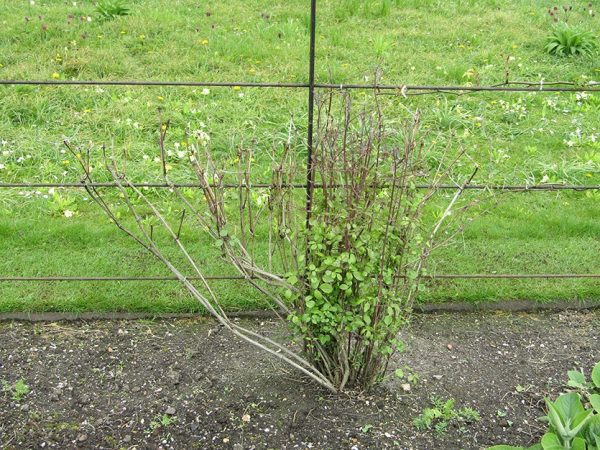
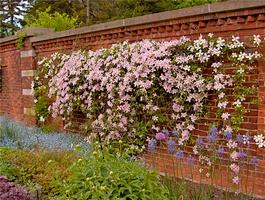
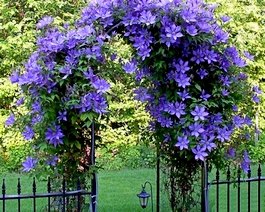
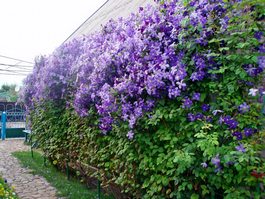
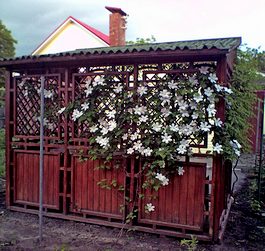
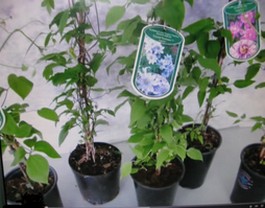

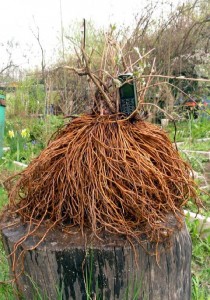
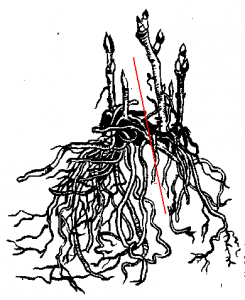
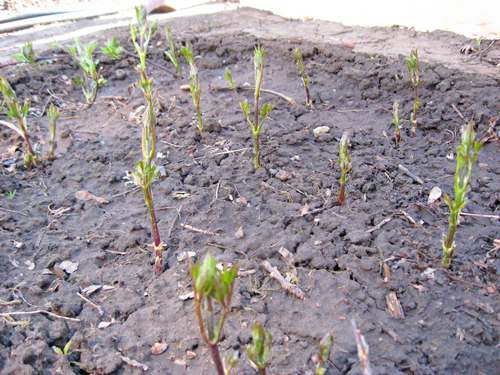
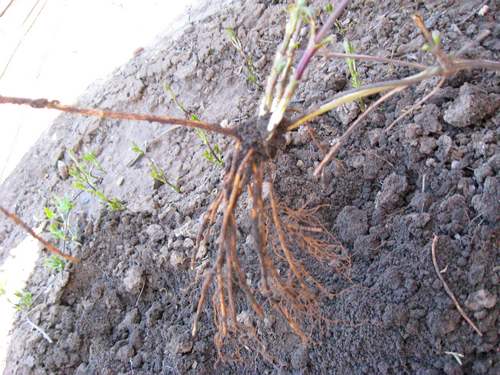

 (8 ratings, average: 4,00 out of 5)
(8 ratings, average: 4,00 out of 5) CUCUMBERS NEVER GET SICK, I'VE BEEN USING ONLY THIS FOR 40 YEARS! I SHARE A SECRET WITH YOU, CUCUMBERS ARE LIKE THE PICTURE!
CUCUMBERS NEVER GET SICK, I'VE BEEN USING ONLY THIS FOR 40 YEARS! I SHARE A SECRET WITH YOU, CUCUMBERS ARE LIKE THE PICTURE! You can dig a bucket of potatoes from each bush. Do you think these are fairy tales? Watch the video
You can dig a bucket of potatoes from each bush. Do you think these are fairy tales? Watch the video
 How our fellow gardeners work in Korea. There is a lot to learn and just fun to watch.
How our fellow gardeners work in Korea. There is a lot to learn and just fun to watch. Eye trainer. The author claims that with daily viewing, vision is restored. They don't charge money for views.
Eye trainer. The author claims that with daily viewing, vision is restored. They don't charge money for views. A 3-ingredient cake recipe in 30 minutes is better than Napoleon. Simple and very tasty.
A 3-ingredient cake recipe in 30 minutes is better than Napoleon. Simple and very tasty. Therapeutic exercises for cervical osteochondrosis. A complete set of exercises.
Therapeutic exercises for cervical osteochondrosis. A complete set of exercises. Which indoor plants match your zodiac sign?
Which indoor plants match your zodiac sign? What about them? Excursion to German dachas.
What about them? Excursion to German dachas.
I want to make several layerings from clematis. Tell me, when is it better to do this in the fall or spring?
If you do everything correctly, the cuttings will take root equally well in both spring and autumn. But in your case it is better to add drops of shoots in the fall, you will get new seedlings faster.
I accidentally cut off the clematis completely at a height of 1-2 buds above the ground. Now 7 vines, 3-5 meters long, hang separately; the ends have been dipped into the water. The vines are old, woody, powerful, with a lot of leaves and flowers. Tell me, please, is it possible to somehow use them for planting? And when to replant a part with roots to a new place? Thank you in advance!
Olga, it’s unlikely that you’ll be able to root cut vines, but you can try. Roll them into rings and bury them in the ground, after cutting off the leaves and flowers. Leave one bud on the surface and cover it for the winter. A friend of mine does this and sometimes his shoots take root in the spring. I tried it once and it didn't work. Maybe you'll get lucky. And September is the time to divide and replant clematis. And sorry for the delay in answering - I was away.